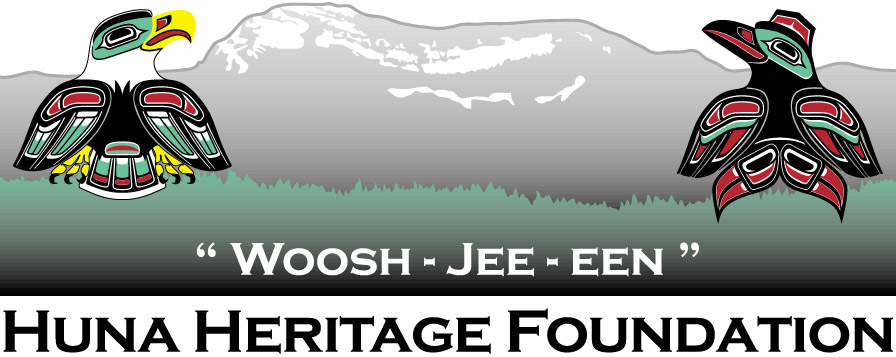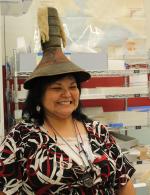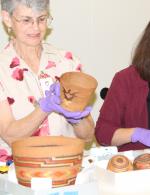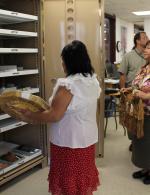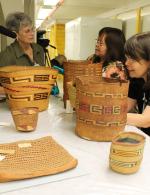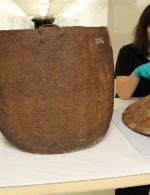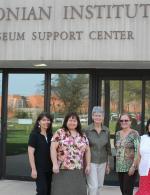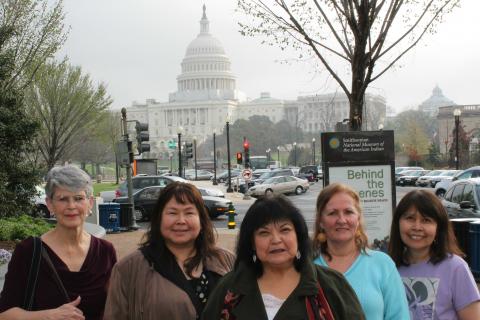Hoonah Weavers Research at the Smithsonian in Washington, DC
In March of 2012, Hoonah weavers Marjorie Peterson, Darlene See, Harlena Warford, Chris Greenwald and Daphne Wright traveled to the Smithsonian Institution in Washington, D.C. to study the Tlingit basketry collections. By examining the collection of basketry and other Tlingit weavings at the Smithsonian, the Hoonah weavers gained an understanding of early weaving designs, techniques and patterns to compare and contrast with contemporary weaving. The weavers observed some weaving techniques and practices that are not commonly practiced today. Huna Heritage Foundation, Smithsonian Institution’s Recovering Voices Program and the National Park Service funded the trip.
Marjorie Peterson is of Yupik and Inupiaq descent and she is the wife of Floyd Peterson, T’akdeintaan of Hoonah. Marjorie began weaving in 1990 with Rita Blumenstein. She weaves cedar bark and spruce root as well as pine needle basketry, Appalachian basketry and Ravenstail weaving. In 2002, Marjorie organized through the Hoonah Art Council for master weaver Delores Churchill to come to Hoonah to teach a beginners spruce root and cedar bark basketry class. Marjorie has been practicing weaving since she first learned and earned her Occupational Endorsement of Northwest Coast Native Art in Basketry from the University of Alaska Southeast. She has been an instructor and hopes to pass on her knowledge to other weavers.
Darlene See is of Tlingit and Aleut descent. Her Tlingit name is Koo dei ya toon and she is of the Kach.adi, Land Otter clan. Darlene has been weaving since the early 90s and has learned, practices and teaches Spruce root, Cedar bark, Chilkat and Ravenstail weaving. In 2004, Darlene and master weaver Delores Churchill started the Occupational Endorsement of Northwest Coast Native Art certificate program through the University of Alaska Southeast. Darlene creates spruce root baskets, covered bottles, earrings, cedar bark hats, baskets, Ravenstail medicine bags, Chilkat medicine bags, aprons, robes, sea otter/seal skin pillows, hats, gloves, silver engraving – earrings, bracelets and pendants, drums and regalia.
Harlena Warford, Tlingit name Aanyaku yaa da gu, was of the Kaach.adi, Land Otter clan. Harlena first learned cedar weaving from her mother, Elsie Wilson and later as an adult from master weaver Delores Churchill. Harlena produced many art forms, including: cedar hats, spruce root baskets, Chilkat purses, octopus bags and regalia. She was a Tlingit design artist and a master song leader and drummer of Tlingit songs. Harlena also learned and practiced the art of making traditional Tlingit medicine.
Chris Greenwald, Tlingit name Kooyeich yawuaa, is an adopted member of the T’akdeintaan clan. Chris took her first spruce root weaving class in 1979 taught by Hoonah master weaver Ida Kadashan. She continued to learn through a progression of other weaving techniques including coil basketry, Appalachian basketry, Ravenstail weaving and beginning Chilkat weaving. In May 2008, Chris earned her Occupational Endorsement of Northwest Coast Native Art in Basketry from the University of Alaska Southeast. Master weavers who have instructed Chris include Ida Kadashan, Delores Churchill, Ernestine Hanlon and Cheryl Samuel. Over the years Chris has taught spruce root and cedar bark weaving.
Daphne Wright, Tlingit name K’ashge is a member of the T’akdeintaan clan. Daphne took her first weaving class in the 1980s taught by master weaver Delores Churchill. When Delores began teaching classes in Hoonah in 2002, Daphne continued to learn spruce root and cedar bark basketry including design, gathering and preparing materials for weaving and different styles of weaving. Daphne has created spruce root and cedar bark baskets as well as cedar bark hats. Daphne is also a long time Tlingit language instructor and teacher at Hoonah City Schools and shares her knowledge of the Tlingit language and culture with the children of Hoonah.
